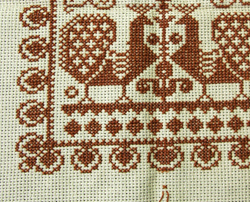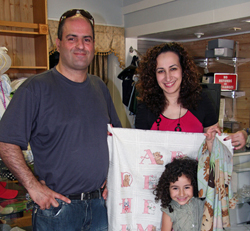Other Shreveport Articles
Cultural Preservation: Keeping the Flame Burning for Future Generations
Seasons and Cycles — Festivals and Rituals Mark Life's Rhythms
Of Hand and Heart: Handwork Connects Family and Community

Palestinian and Mexican Handwork Traditions in Shreveport
By Laura Marcus Green
Reema Samander: Designing a New Life with Traditional Skills
Reema Samander began learning cross-stitch embroidery from her mother when she was eight years old. Reema's mother is an accomplished crocheter and knitter, but she doesn't necessarily enjoy doing cross stitch. Reema considers her mother and herself to be modern Palestinian women, who wear contemporary clothing. Nonetheless Reema remembers that when she was growing up, everyone was doing cross stitch, so she asked her mother to teach her how. Reema recalls, "She started showing me how to do [it] stitch by stitch. And I picked [it] up fast. And since then I started with the cross stitching [and] never stopped." In the beginning, Reema learned some of the traditional patterns. These days, living far from her home country, she consults books and the internet for Palestinian embroidery designs. She says, "We copy it from generation to generation, we keep it always."
Reema was around 14 years old when she began making things for her jihas, or trousseau. She was almost 22 years old when she married her husband, Sam Samander. By then, she had produced a sizeable collection of cross-stitched linens, pillows, table runners, and pictures and wall hangings to take to her marriage. The literal translation for jihas is "preparation." Reema explains what goes into a woman's jihas: "The stuff the bride needs, like embroidery things, or cross stitching, pillows, sheets, bed sheets, you know, stuff for the home. Plus the bride's clothes. This is what we call a jihas. You know, everything she needs for her new house, like a new beginning."

While she created a treasure trove of cross-stitched items for her jihas, she also pursued a college degree at Berzeit University. In 2001, Sam and Reema left Palestine to visit family in the United States. At the time, the couple was expecting their second child. With conflict rocking their home country, they realized that their children would have more opportunities and lead more comfortable lives in the U.S. They ended up staying on to help Sam's brother with his Shreveport-based business.
Reema and Sam Samander come from a culture and family network for whom change is a constant. As Sam points, out, Palestinians have had to move and adjust to living in many different places in the world. Sam and Reema's hometown, Berzeit, Palestine, has been home to the Samanders and the Shahins (Reema's family of origin) for many years. Over time, a series of historical events and political issues have led residents from Berzeit to leave. Sam's grandfather's family left Palestine in 1895 to live in the Virgin Islands. Fifteen years later, the brothers in the family chose Sam's grandfather to return to Palestine in order to maintain a connection with their homeland, attend to their aging mother, and see to the family olive farms. Now spread across the globe, the Samander family and others with roots in Berzeit stay connected through annual conventions of the Berzeit Society. The society encompasses six tribes, four of which are Christian and two are Muslim. The convention features folklore exhibits, parties, banquets, and fundraising events to support fifty scholarships given each year to Berzeitese who are pursuing undergraduate degrees.
Living in Shreveport, Sam and Reema have applied their energy and talents to establishing their own business, Reema's Specialty Company. Reema's offers a wide range of services, including custom embroidery, graphic design and digitizing, screen printing, and window treatments. The store carries gifts for special occasions, as well as carved olivewood products from the couple's homeland. Reema's also offers custom-designed clothing and alterations. Reema learned to sew when living in Palestine, but it wasn't until she settled in Shreveport that she developed her skill as a seamstress. Before, she did clothing alterations and customization for herself and her family. She has worked hard to become the highly skilled designer and seamstress she is today. About the steep learning curve she has traveled, she says, "You know, you just need a little bit of education and common sense." Having learned cross-stitch and crocheting as a child, she adds these traditional skills to the services she offers her customers. Reema believes she may be one of the only businesses in town where people can bring their crocheted items for repair.

In addition to being a full-service tailor, Reema designs, sews, and alters wedding attire, as well as costumes for Halloween, Mardi Gras, and other occasions. Reema has also found a niche market in the local film industry. During Shreveport's boom years as a film location, a set designer came into Reema's one evening, asking whether she could take an actress's costume from a 3X to a medium by 6:00 am the next morning. Overnight, Reema accomplished this feat by taking apart and re-stitching the costume. Word quickly spread that Reema's is a place to have costumes made and fitted, for cast and crew.
Both Sam and Reema have accounting degrees from Berzeit University. Not surprisingly, their professional skills are a plus for running their business. Reema also uses her mathematical skills in her sewing work. She observes, "You know, numbers are always good, even in sewing. We have to do mathematical equations and things. Dimensions for the body—you know, I have to calculate everything before I start doing a pattern or customizing anything. Because there is no way for mistakes. It should be right from the first time, that's my policy."
Photo: 35. Caption: Reema Samander with a wedding dress that she designed and sewed. Photo: Laura Marcus Green.
Reema learned to strive for perfection when she began doing cross-stitch embroidery as a little girl. She observes, "Cross stitching, you should be super patient. It's not easy to be done and if you just mix up one stitch, you have to take off the whole thing and go back again. That's why it needs time. And I don't know, I have the patience to do that." When Reema was growing up, cross stitch was used to make beautiful pieces for the home, mostly table runners. She is continuing this tradition in her Shreveport home. "We like to display it when people come to visit. You know, for table runners? Always I have to have it in my house. Pictures like we use at Christmas time, I display it. I take some off of the wall, and put these new ones in at Christmas time, to keep switching for the season."
Although knowledgeable about traditional Palestinian cross-stitch designs, Reema enjoys making contemporary pieces as well. She says, "That's me always, you know, I don't go with just traditional or just modern. I like to mix." The pieces she has with her in Shreveport include a traditional Palestinian piece, a Greek design, several Christmas pieces, and a piece depicting Our Lady of Guadalupe, whose image is found in many homes in Berzeit, a predominantly a Christian town. One of Reema's favorite pieces is a design she copied from a Christmas card. In addition to basic cross stitch Reema does the star stitch, a modern stitch her mother showed her that has three overlapping stitches to create a star, rather than the standard two stitches in cross-stitch.
Although it was once a prevalent cultural tradition, Reema believes that there are not many people doing Palestinian cross stitch these days. She says that most older women in Palestine today knit and crochet. Few in Reema's generation or younger have the patience or time to do hand work. Scrolling through family photos she has stored in her smart phone, Reema finds examples of older generations of women in her and Sam's families who still wear the cross-stitched traditional dresses every day. They are stunning to behold, the women and their dresses. Both Reema and Hanieh Salama observe that it is only the eldest members of society who continue to wear the traditional dresses on a regular basis.
If patience is a key to the art form's survival, perhaps enjoyment is another. For contemporary women, there are many competing demands on their time. Whereas earlier generations did not work outside the home, younger women have little time left over after caring for their families and working. Like the women of her grandmother's generation, Reema finds a welcome refuge in her cross-stitch. Looking back to her college days, she reflects,
You know, I love doing cross stitch. Every stitch for me means something, because I'm stealing time to do these things. You know, all day, busy with school, college, whatever. And evening time, you know, we have to study. So if I got like five minutes, ten minutes, an hour, I'll just use it [for] doing something good like cross-stitching things. And still today, if I have five minutes, I just go and get my stuff and start stitching. It's kind of relaxing. And it's nice, even if it takes me one year to finish a piece. This is the only hobby that relaxes me. Or drawing sometimes . . . I draw dresses, fashion design. You know, any kind of crafts, I'm interested in. A lot of different things.


